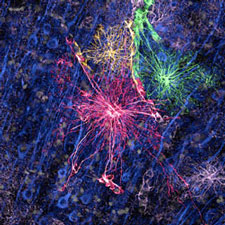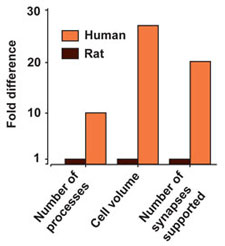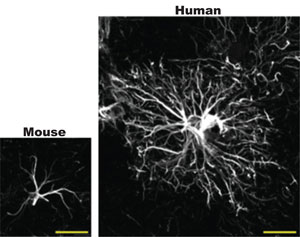Evolutionary Changes of Astrocytes
One of the most basic but fundamental questions underlying the study of brain science is understanding what factors account for the differences in interspecies intelligence and computational power. Sophisticated cognitive abilities, such as an unparalleled capacity for learning, language, abstract expression, and metacognition are said to set humans apart from animals. But what accounts for these differences? Classically, interspecies variation in intelligence has been attributed to neurons, the electrically excitable subunit of all nervous systems. However comparisons between the brains of different species indicate that the proportional make up and sophistication of a different, historically underappreciated, type of brain cell increases as a function of increased cognitive capability.
In species with more capable brains, astrocytes – a type of non-electrically excitable brain cell, also known as neuroglia— account for a considerably higher proportion of the brain. More importantly, human astrocytes are 20-fold larger and much more complex than rodent astrocytes. The correlation between proportional makeup and intelligence suggests that astrocytes, which were first discovered by Rudolf Virchow and later Camillo Golgi, in the late 1800’s, may be more involved in sophisticated neural processes than previously considered. Indeed, rapid advances in the field of glial biology have depicted a much more active role for astrocytes, one which is now widely considered to be critical for coordinating many basic physiological and higher order cognitive processes, such as control of respiratory rate and the dynamics of cerebral blood flow, regulation of the sleep wake cycle, and the facilitation of learning and memory, among others. Still remaining to be discovered are how human astrocytes functionally differ from their rodent counterparts and how these differences contribute to more complex information processing.
Nevertheless, observations of neuro-glial interactions have spurred great interest in developing glial targeted treatments for neurological disease. Although a number of glial targeted therapies, such as the treatment of neuroinflammation and chronic pain, have been shown to be effective on animal models in the laboratory setting, they have largely failed to predict human outcomes. The exact source of this discrepancy remains a contentious issue in science; however, recent research suggests that part of the reason may be due to differences in how astrocytes evolved in different species.
Efforts at contrasting the evolution of astrocytic form and function are ongoing, however, given that current neuroscience research and the development of treatments for neurological disease heavily depend on drawing parallels between humans and animal models, understanding the evolution and interspecies variability of astrocytes is particularly important. Work in our lab has demonstrated that compared to rodents, the average protoplasmic astrocyte from the human neocortex exhibits 10-fold more primary processes and is more than 20-fold larger in volume. Interestingly, our analysis using two-photon imaging of the photolysis of caged Ca2+ in fine astrocytic projections revealed that the speed at which astrocytes communicate with each other, via the propagation of calcium waves, is also faster in humans than it is in rodents.

Neurofilament staining of human astrocytes.
Our hope is that furthering our understanding of the evolution of astrocytes and how they differ between species will help overcome the obstacle of how to extrapolate and apply the findings from animal studies to human disease. Current work is focused on characterizing a fundamentally new way to study human glial cell interactions. We recently generated chimeric mice that have been engrafted with human glial progenitor cells that differentiated into human astrocytes. In an unexpected finding, as the engrafted human cells developed, they displaced the native mouse glial cells. Interestingly, the chimeric mice also exhibited heightened functions compared to control animals, such as improved learning and memory. As the first of its kind, this new model offers the unique opportunity to study the functions of human glial cells in animal models of neuropathologies, in vivo, in real time. Our hope is this work will further our understanding of the differences between rodent and human glial cells, and that it may lead to new insights into why animal models of disease often fail to predict human outcomes.
This project is a collaboration between the Goldman Lab and the Nedergaard Lab.
Further Reading
Forebrain Engraftment by Human Glial Progenitor Cells Enhances Synaptic Plasticity and Learning in Adult Mice. Han X, Chen M, Wang F, Windrem M, Wang S, Shanz S, Xu Q, Oberheim NA, Bekar L, Betstadt S, Silva AJ, Takano T, Goldman SA, Nedergaard M. Cell Stem Cell. 2013 Mar 7;12, 342–353.
Heterogeneity of Astrocytic Form and Function. Oberheim NA, Goldman SA, Nedergaard M. Methods Mol Biol. 2012;814:23-45. doi: 10.1007/978-1-61779-452-0_3. Review. PMID: 22144298.
Uniquely hominid Features of Adult Human Astrocytes. Oberheim NA, Takano T, Han X, He W, Lin JH, Wang F, Xu Q, Wyatt JD, Pilcher W, Ojemann JG, Ransom BR, Goldman SA, Nedergaard M. J Neurosci. 2009 Mar 11;29(10):3276-87. doi: 10.1523/JNEUROSCI.4707-08.2009. PMID: 19279265.
Astrocytic Complexity Distinguishes the Human Brain. Oberheim NA, Wang X, Goldman S, Nedergaard M. Trends Neurosci. 2006 Oct;29(10):547-53. Epub 2006 Aug 30. PMID: 16938356










